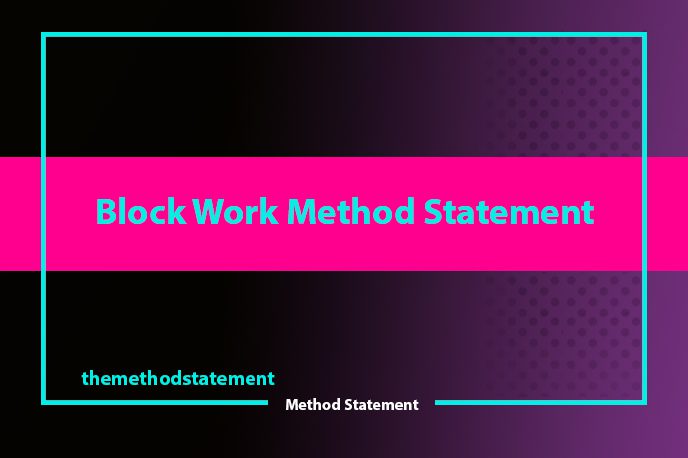Table of Contents
Objective
The Block Work Method Statement outlines the steps to be taken for constructing block work masonry in compliance with the contract specifications and drawings.
Procedure
1. Precast concrete masonry block work will be carried out following the specification and Project Quality Plan.
If specifications are not provided or are incomplete, the matter will be referred back to the consultant’s representative for additional information.
2. Pre-Construction Checks:
a. Verify that the area for block work is as per the contract drawings and approved finishing schedule.
b. Confirm that preceding activities have been inspected and approved.
c. Ensure that blocks are procured from the approved manufacturer(s), with each material obtained from a single source, unless approved otherwise in writing.
d. Obtain source certificates for all raw materials (e.g., sand, cement, and blocks) to demonstrate compliance with the contract specification.
3. Handling and Storage of Materials:
a. Deliver blocks to the site palletized and offload them as near to the point of use as practicable on a clean, hard surface free from contamination by mud or surface water.
b. Store cement off the ground, keep it dry and use it in order of delivery.
c. Store metal ties and straps under cover, protecting them from damage and distortion.
4. Preparation of Work, Materials, and Components:
a. When distributing materials and components to the work area, ensure that the structure is not overloaded.
b. Plan for scaffolding material required for block work at heights and for additional manpower for lifting blocks at heights.
c. Set out anticipating the position of openings in the work above to avoid unnecessary cutting and adjustment of masonry units leading to incorrect or uneven bonding.
5. Preparation of Mortar Mixes:
a. In order to ensure the quality of construction, it is important to follow certain guidelines when preparing mortar mixes and building block walls. Here are some key points to keep in mind:
6. Mixing of Mortar:
a. Machine mixing is recommended for preparing mortar mixes, except for small quantities that do not contain plasticizers. Hand mixing, if permitted, may be done on a watertight platform.
b. When mixing mortar on-site, use batch boxes to ensure the correct and consistent mix proportions.
c. Mortars, other than retarded mortars, should be used within two hours of mixing or as specified.

7. Building Block Walls:
a. Build block work within permissible deviations as specified.
b. Unless otherwise specified or permitted, lay blocks on a full bed of mortar and fill all joints. Keep courses level and vertically aligned. Plumb quoins and all faces as work proceeds. It is preferable to align vertically every fifth or sixth perpend and maintain uniform thickness for intermediate joints. Try to keep horizontal joints of uniform thickness.
c. Do not carry one course more than the height specified in the contract specifications.
d. Rake out joints as work proceeds, on all faces to be plastered or rendered. This will provide a good key for the coating.
e. If pointing is specified, the mortar used for pointing should not be stronger than that used when constructing the wall unless specified otherwise.
f. All blockwork should be bonded to adjacent reinforced concrete structures by means of galvanized mild steel cramps at specified spacing unless specified otherwise.
g. Partitions should be bonded to the main walls by toothing as specified in the contract.
8. Chases and Holes:
a. Cut chases and holes neatly and without damaging the walls as per the following unless specified otherwise:
b. Chases in blockwork should be less than 75mm.
c. For hollow units, maintain a minimum of 15mm thickness between the bottom of the chase and the void.
d. Do not cut horizontal or raking chases to a depth exceeding one-third the thickness of the single leaf in walls or leaves contracted of solid units.
e. Holes should not exceed 300mm x 300mm unless specified otherwise.
f. Do not cut chases back-to-back exceeding the dimensional restrictions in (b), (c), and (d). Offset such chases in line by a distance at least equal to the wall thickness.
g. It is preferable to use mechanical rotary cutters, particularly when it is necessary to avoid heavy impact and vibration. The number and position of chases should strictly adhere to the specification since unauthorized chasing might adversely affect one or more of the functional requirements of the walls, such as its loadbearing capacity.
h. In addition, record deliveries of blocks if required by the specification.
See Also: Method Statement for Civil Engineering
Quality Control of Block Work Activity
Prior to Commence Block Work Activity
- Setting out (openings etc.)
- Check the source material certificates of sand, blocks, accessories, and cement.
- Check the mixture proportion of mortar.
Checking During Block Work Activity
- Check alignment and width of perpends.
- Check the line and level of block courses.
- Check the metal ties and accessories
- Check the raked-out joints.
- Check the toothing at the joint of the main walls with partitions.
- Check the compliance of chases as per the specifications.
Personnel-Method Statement Block Work
QA/QC – Quality Assurance/Quality Control Engineer,
PE – Project Engineer,
SE – Site Engineer,
SU – Surveyor,
GF – General Foreman
This Might Interest You: Method Statement for Installation of Solar Panel
tag: # Block Work Method Statement
method of statement block work
